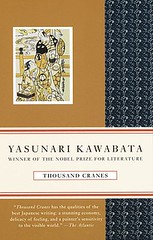
Thousand Cranes / Yasunari Kawabata
Sembazuru. English
New York : Vintage International, 1996
Originally published: 1952
Translated by Edward G. Seidensticker
vi, 147 p.
With a restraint that barely conceals the ferocity of his characters' passions, one of Japan's great postwar novelists tells a luminous story of desire, regret, and the almost sensual nostalgia that binds the living to the dead.
Like Kawabata's other novels, Thousand Cranes is a simple story delicately told through highly self-examining characters. Kikuji, after losing his father, attends a tea ceremony hosted by his father's former mistress, Chikako. She intends to set him up with a young girl with a handkerchief with a thousand cranes on it, but he instead becomes involved with Mrs. Ota, his father's mistress for whom he left Chikako. Their affair brings her shame, for which she commits suicide, and he comes to transfer his feelings to Fumiko, Mrs. Ota's daughter.
I just checked Wikipedia, and my summary is almost identical to theirs, but I swear I didn't copy it. It's just... that's all there is to say about the plot.
It's a lovely, quiet novel, though I'm fairly certain I didn't completely grasp it. Lots of it resonated, especially the themes of loss, grief, and regret. My favorite aspect of the novel was how Kawabata uses objects as vessels for memory with tea bowls and utensils carrying an ownership history that comes alive through interaction with the object, especially the difference between interaction in a tea ritual vs. using the object for non-traditional purposes. The objects and their treatment speak louder than the people often do.
And yet, there was something in the novel that didn't exactly strike me properly. It is most likely the cultural divide, but I didn't always understand the rationale behind some of the characters' behavior. Chikako was the most clear-cut with her leftover bitterness at being dismissed in favor of Mrs. Ota. She is outspoken, gossipy, and openly-conniving. I believe on a personal level, I was so divorced from the experiences of the other characters because I've never experienced anything like they have.
Nonetheless, even without forming a profound personal connection as I did with The Master of Go, the rich artistry of this novel makes it stand out against its contemporaries and distinguishes Kawabata as a master of his craft.



this is a very interesting review. I will add this work to my now out of control TBR list for the Japanese Challenge
ReplyDeleteI agree with Mel, it really is a very interesting review. I'm making a mental note to check this book out.
ReplyDeleteHere's one of my favorite lines from your fascinating review: "how Kawabata uses objects as vessels for memory". I find myself being very nostalgic about obejcts that would have no meaning for someone else, but conjure up great moments of joy (or sorrow ) for me. A thing as simple as my son's baby shoes will strike me to the core. I haven't read much of Kawabata, just a few stories from First Snow on Fiji, but I do love the simplicity and beauty which replaces a plot so many times in Japanese fiction. This book sounds fascinating, especially as I have a secret (or, not any more ;) goal of folding 1,000 origami cranes. Just to see if I can do it. Although, it'll seriously cut into my reading time.
ReplyDeleteOh so awesome. I love the title of this novel and the use of objects in a subtle manner. Very ingenius and masterful.
ReplyDeleteI've never heard of this author, and I love the title of both of the books. Will have to add this to my list of authors to check out.
ReplyDeleteI like that you chose to read one of the older novelists.
ReplyDelete